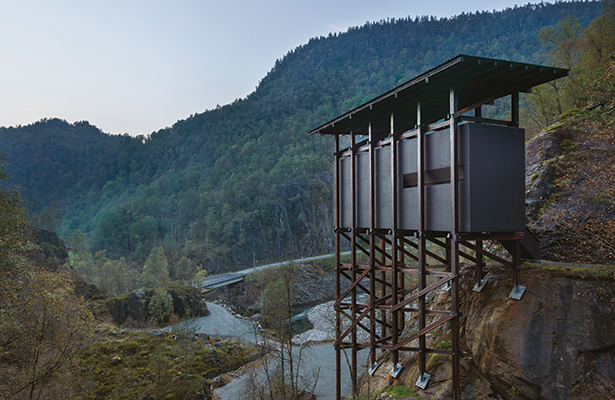|
|
||
|
Perched on stilts high above a ravine, the primitive structures of the architect’s Allmannajuvet museum carry echoes of the area’s troubled past On a rocky ledge, high above the Allmannajuvet ravine near Sauda – a small town deep in the fjords of south-west Norway – is a Second World War pillbox. From inside, you can see the commanding view a gunner would have had over the road that snakes below. Europe’s largest aluminium smelting plant was then in Sauda, powered and cooled by the area’s waterfalls and rivers, and it was a strategic position after the German invasion in 1940. Now, the Swiss architect and Pritzker laureate Peter Zumthor has built four timber structures in these remote mountains that echo the military battlements. In 2002, Zumthor was commissioned as part of Norway’s Tourist Route initiative – which has commissioned over 50 architects to create ‘spectacular architecture in magnificent landscapes’ – to design a small museum and cafe to commemorate the zinc mine that operated here in the 1880s. (Zumthor had already created the cocoon-like Steilneset Memorial in Vardø, at the northern tip of the route.) The resulting buildings, perched on stilts along the ravine, are supposed to reflect the archaeological remains of the makeshift mine buildings. However, with their slit-eyed windows, and wooden walls covered in hemp cloth and tar, they have a stealthy military air that perhaps refers more to the Nazi occupation, which the Norwegian government would rather ignore.
The museum building also hangs suspended – from a frame of timber supports The first building at which visitors arrive is a roadside toilet block, cantilevered over the river from a huge stone wall, like a medieval garderobe over a castle’s moat. The core of the building sits in a frame of treated pine, with a corrugated zinc roof elevated above it, much as the Steilneset Memorial does. The walls have a textured finish familiar to visitors of Zumthor’s 2011 Serpentine pavilion, with its secret courtyard garden, where he first explored this technique of covering a facade with coated scrim. The dry stonewall off which the building hangs is impressive, with huge boulders jigsawed together to create what, from some angles, looks like a massive dam designed to halt the river that runs below. |
Words Christopher Turner
Photography Andrew Meredith |
|
|
||
|
The toilet block is cantilevered from the side of a stone wall |
||
|
On a craggy hill above is a cafe, with low, ribbon windows and a kitchen with units and furniture designed by Zumthor, whose obsessive attention to detail has seen him not only choose the souvenirs on sale, but even create the recipe for the beef and vegetable soup which is the only fare on offer. The £9.5 million project was subject to a decade of delays as a result of the architect’s legendary perfectionism, and because the crumbling mountainside had to be stabilised with long metal pins. The narrow gorge is undeniably dramatic, its mossy sides rising high above you. There are waterfalls and avalanches of boulders everywhere, some of which had taken out one of the bridges on my visit, making our progression precarious. As you walk further down this eerie path you come to the museum. Like the cafe, it is a box suspended high above you in a timber frame beneath a cambered corrugated zinc roof. Again, one enters via a bridge, creating the impression of a building hanging in vertiginous space. It contains some of the mine’s few surviving relics – a wooden clog, the head of a pick axe, a lamp, a shovel – and a history and plan of the site.
The exhibits include a pick axe and other tools from the 19th-century mine As you walk up to the mine entrance, you pass a steel cable that crosses the river, on which hangs a metal bucket that the zinc ore would have been pulled up in. The mines were in operation from 1882 to 1898, and during that period over 12,000 tonnes were extracted. Zumthor hopes that his primitive, hard-edged structures will capture something of ‘the drudgery’ of this work, and the ‘strenuous everyday lives’ of the 168 employees. The rock was hewn from the mountainside and hauled to the surface in trolleys, the rusty rails of which still survive, before being broken up and carted down the mountain to waiting boats. These took the ore as far as Cardiff, where it was turned into pots and pans. The highlight of any trip to Allmannajuvet is obviously a trip down the mine itself, for which you need a guide. Some of the mine shafts and lower levels have been shored up and restored. ‘The working conditions must have been terrible,’ says Zumthor. ‘You cannot stand upright in the tunnels; you have to go miles into the mountain, where it’s cold in summer and winter. So it gave us the idea to be modest in everything we did. Not poor, but modest.’ At the cave-like entrance, a final building was planned – an unwalled structure under a canopy at which visitors pick up their hard hats – but because of the unstable terrain it was never built. Here, visitors are led down – like the miners who once toiled here – through a hole in the mountain, the walls dripping with salt crystals, into the claustrophobic darkness. |
||
|
The museum teeters over the landscape and is entered via a bridge |
||
























